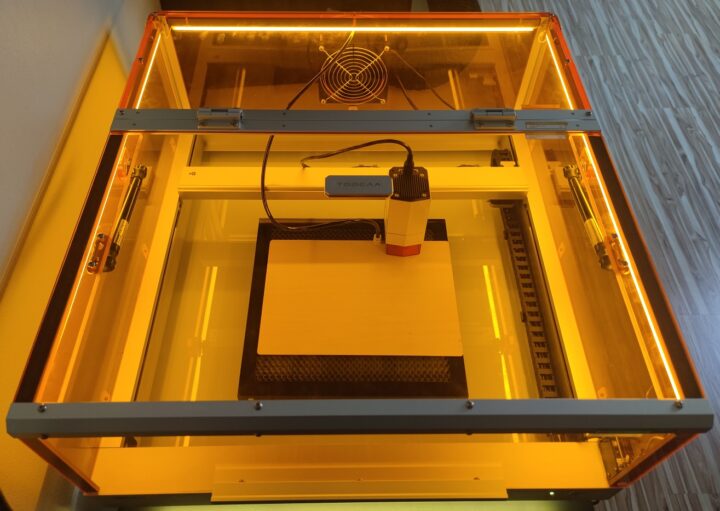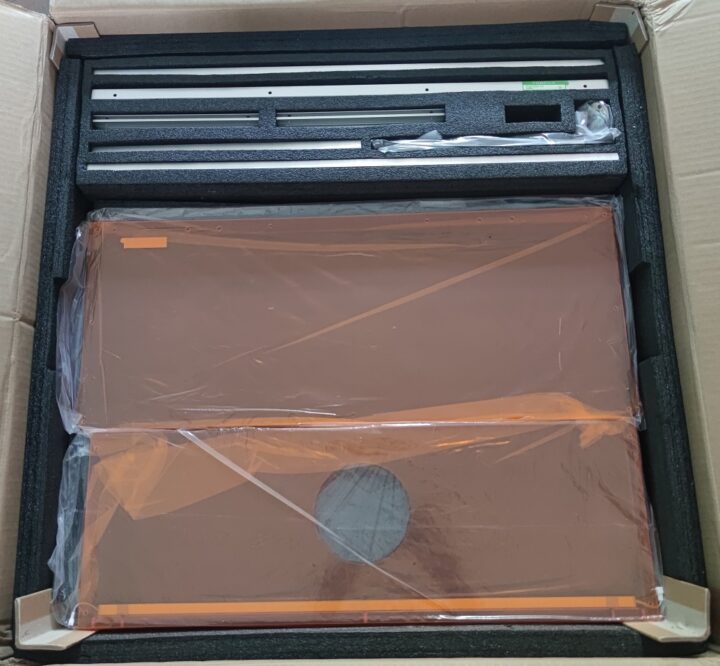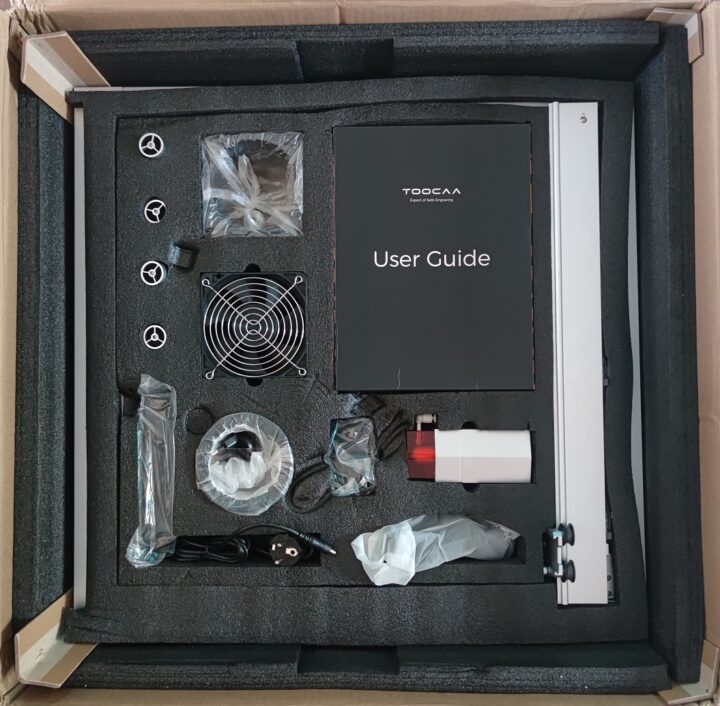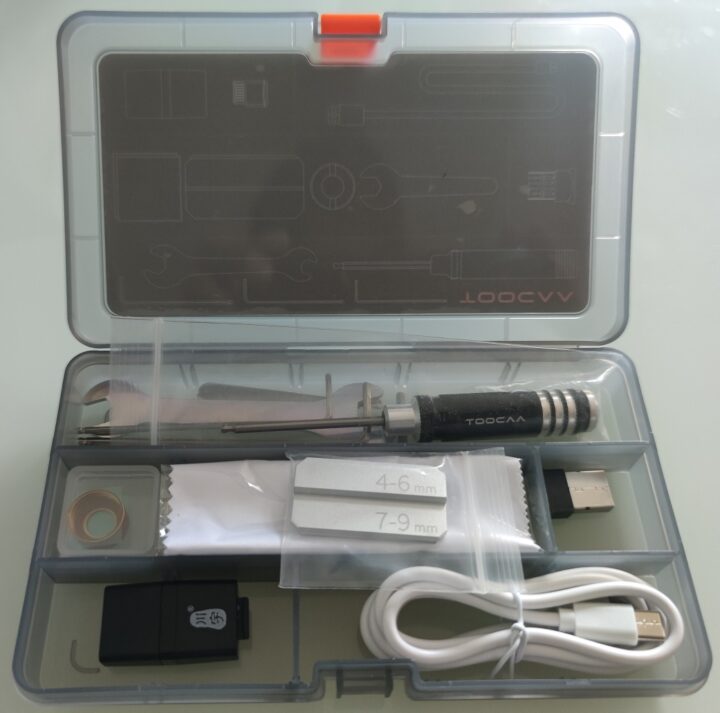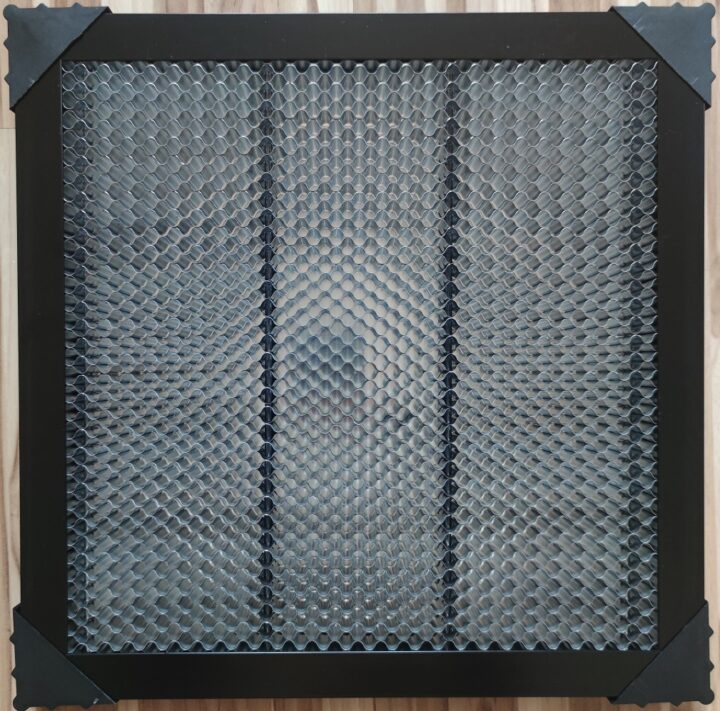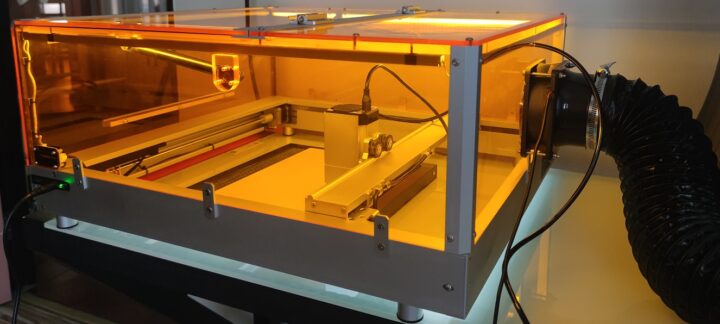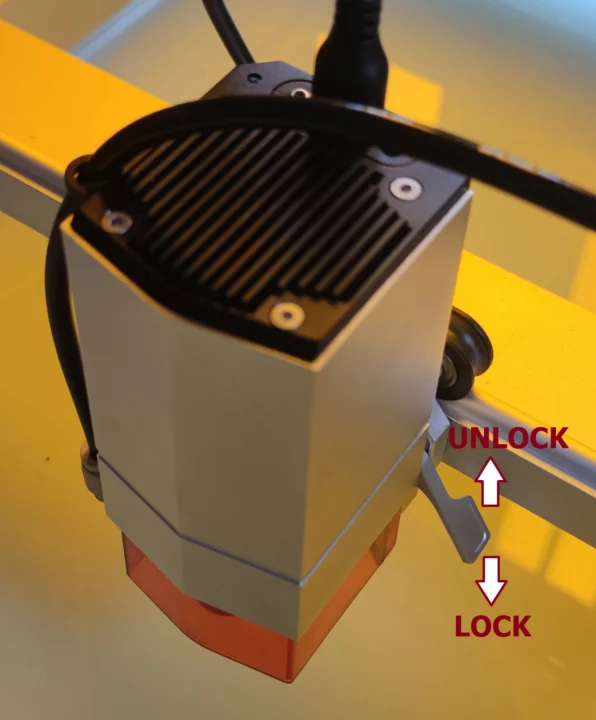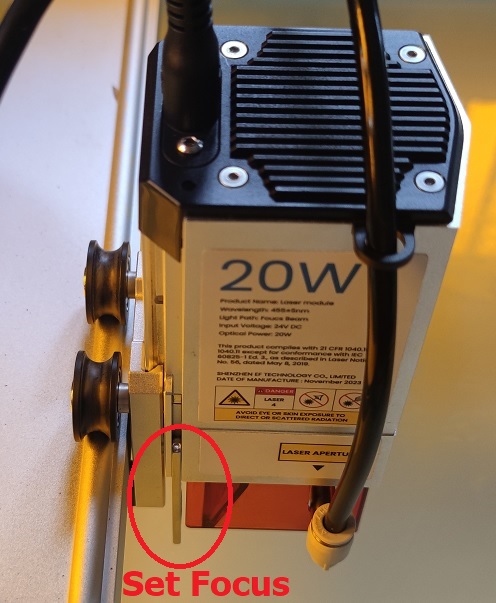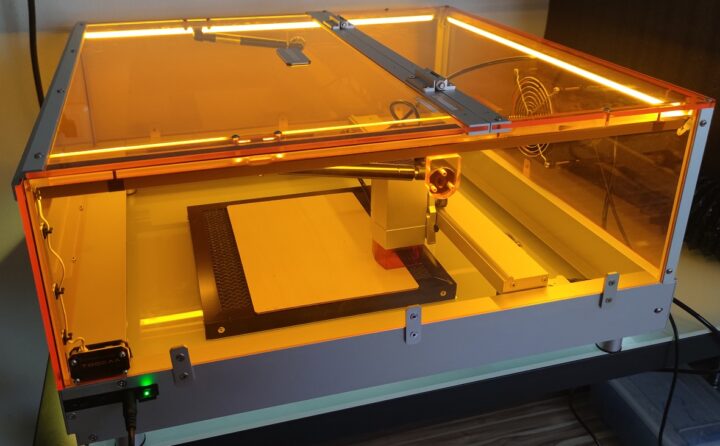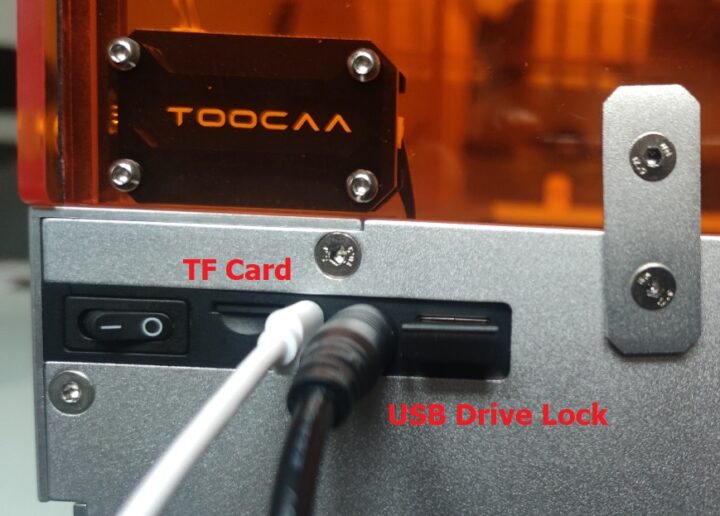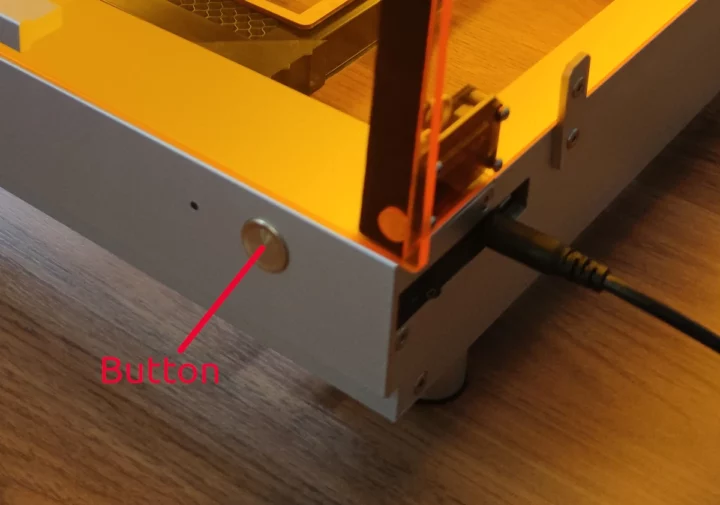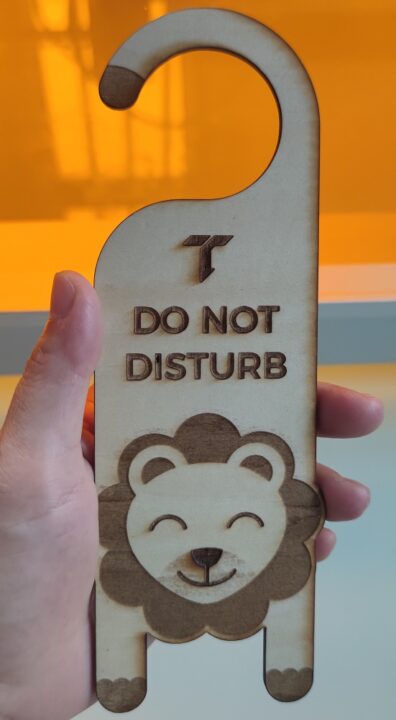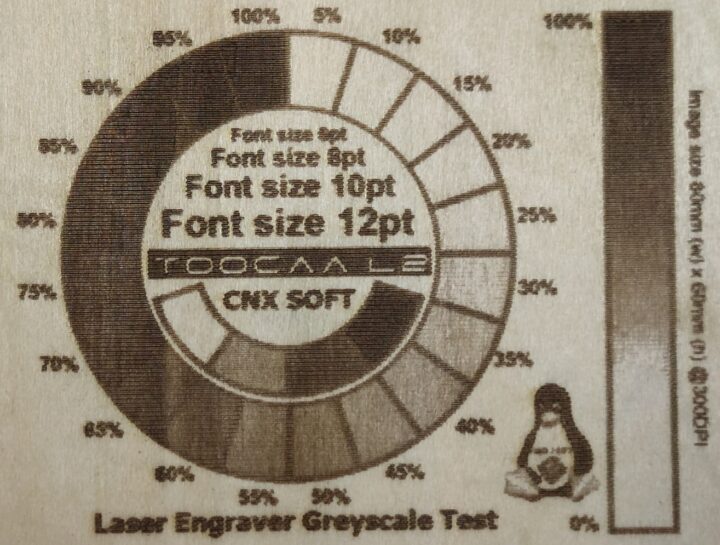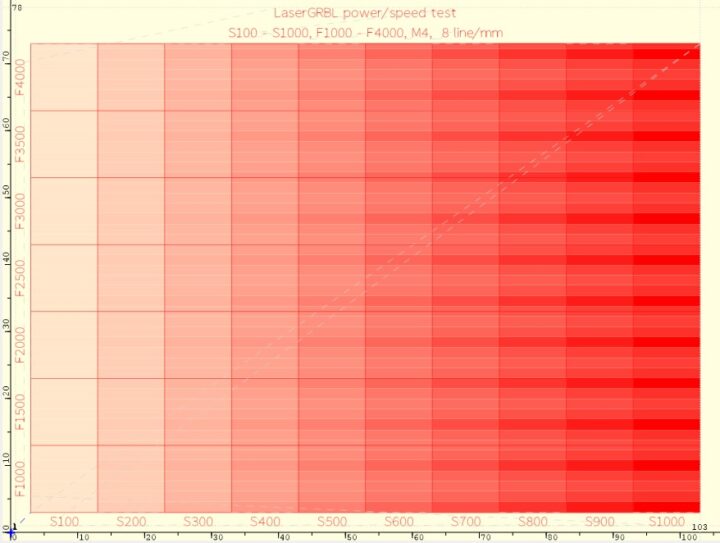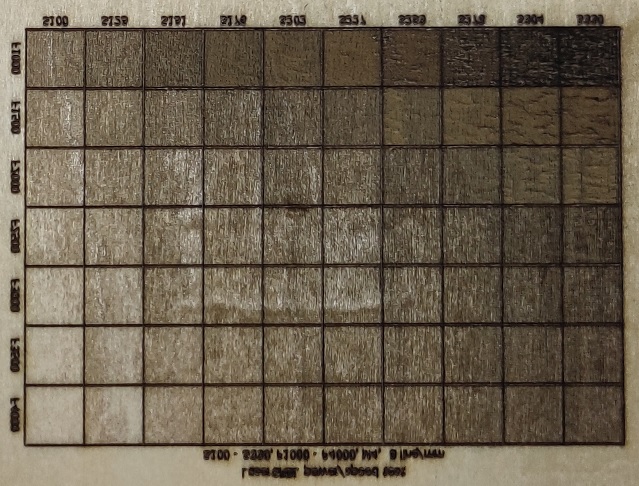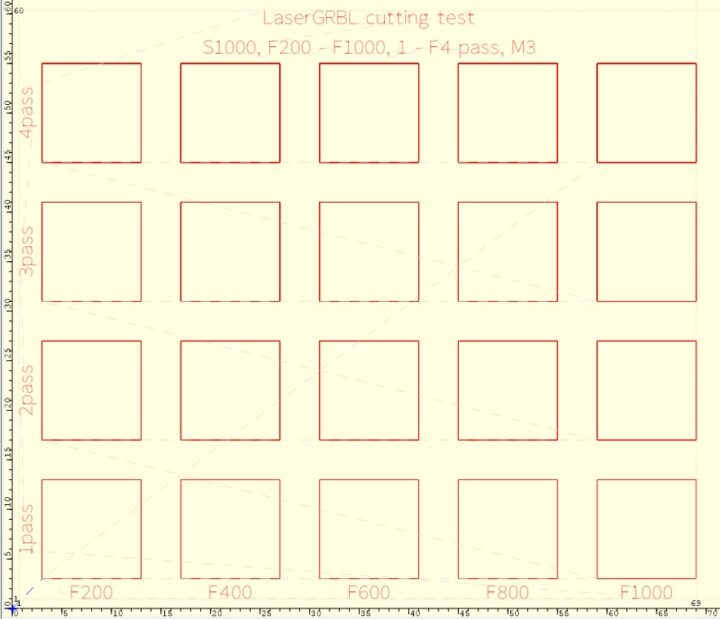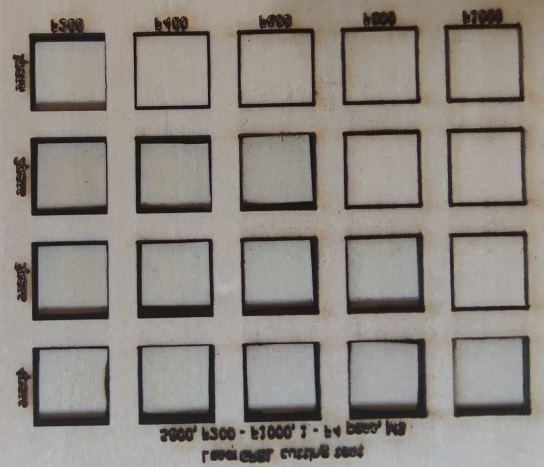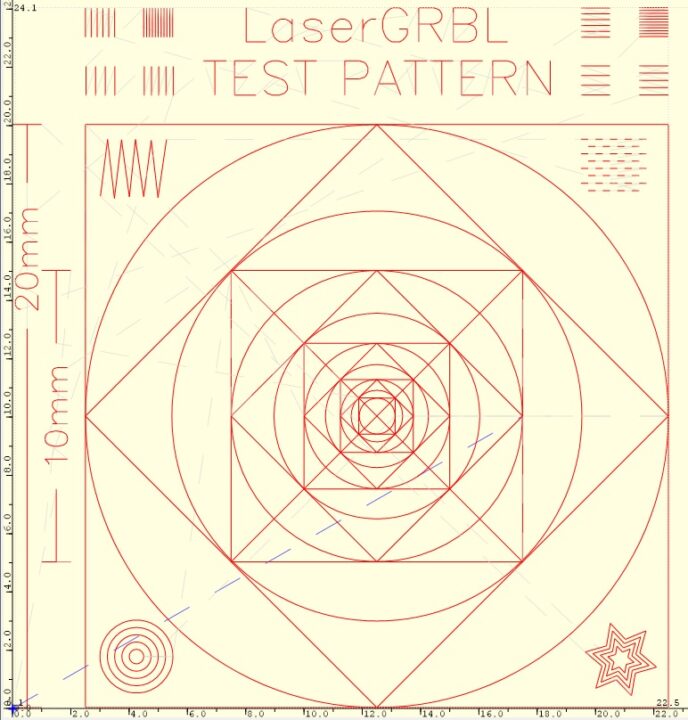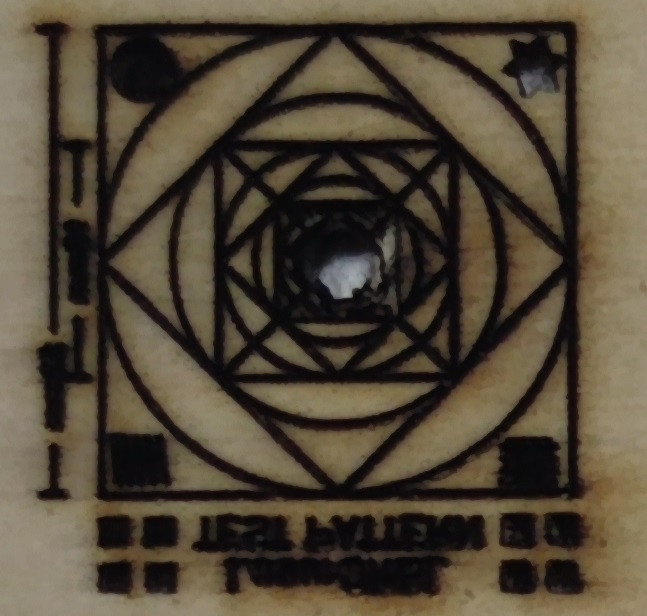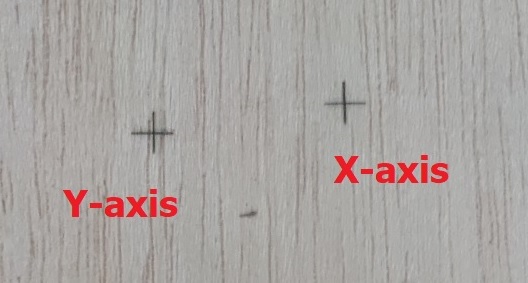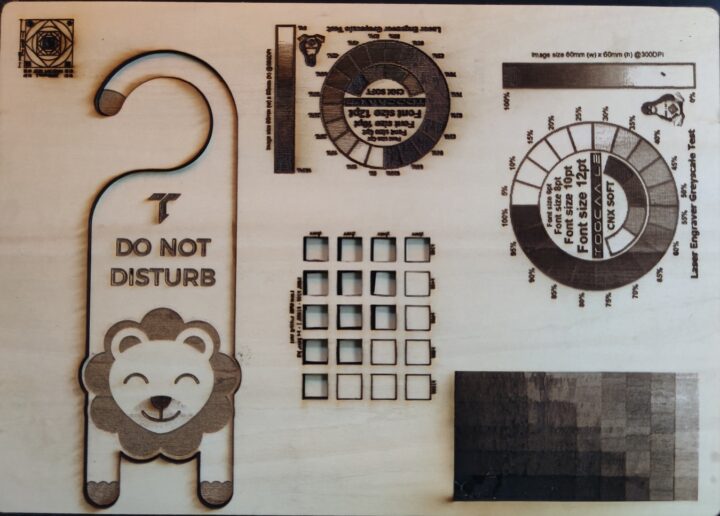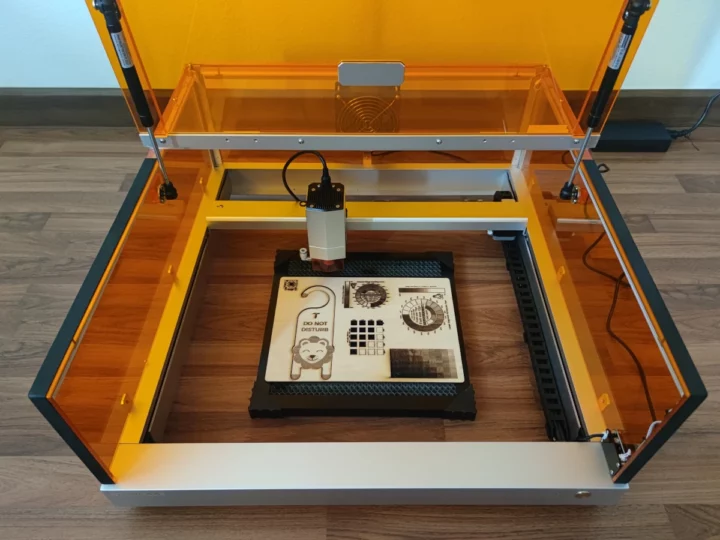TOOCAA L2 is a fully enclosed laser engraver and cutter with a 10W or 20W laser module using orange acrylic covers and various sensors for additional safety. The laser module complies with Class 1 Laser Safety certification and the engraving and cutting machine works with a range of materials suitable for creators who want to cut or/and carve workpieces or manufacture high-resolution parts.
The company sent us a sample of the TOOCAA L2 with a 20W laser model, an air assist pump, a honeycomb plate, and a few consumables for review. We’ll first go through an unboxing of all items and assembly, before testing the laser engraver and cutter under various scenarios.
TOOCAA L2 unboxing
The review kit we received includes three packages from TOOCAA. Each package contains various components. with foam drilled into shape to support each part and right-angled cardboard along all four corners of the package to prevent damage during transportation. Let’s open those to find out what we’ve got…
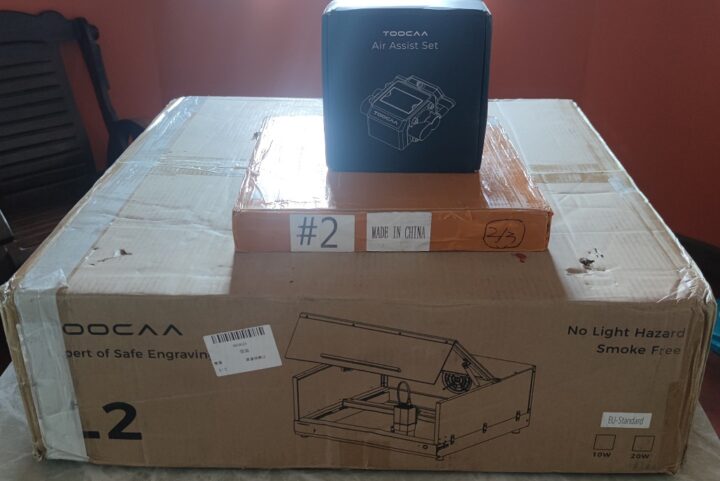
The large box comes with the TOOCAA L2 laser engraver.
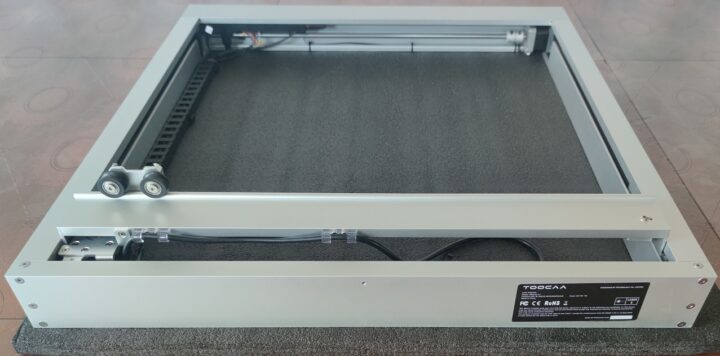
The laser module features diodes that emit light using electricity with a wavelength of 455 nanometers +- 5 nanometers. It uses 24V direct current power, 20 Watts of power, and comes with a system to protect against laser beams and a blue light filter.
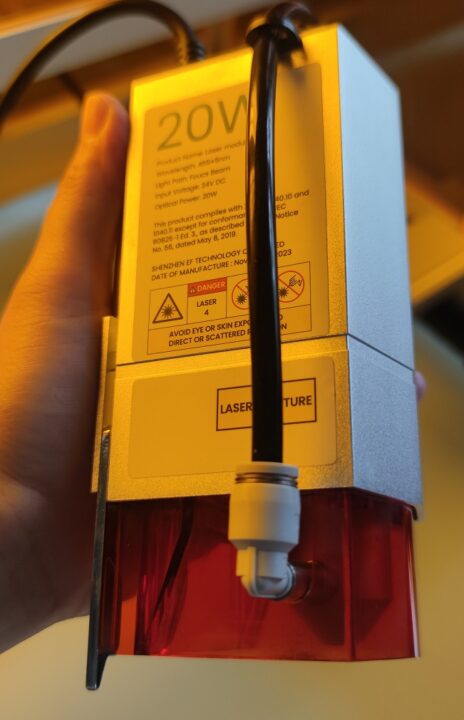
There’s also a retractable aluminum foil exhaust duct to get rid of fumes through your window or other opening.
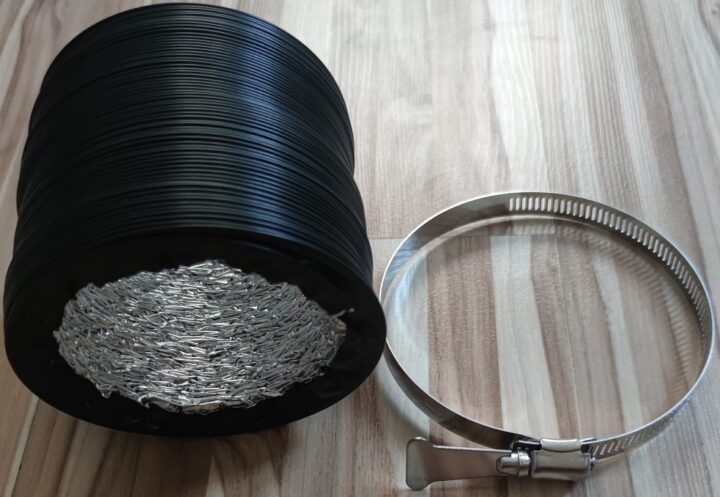
The enclosure is comprised of six orange clear acrylic sheets, each 5 millimeters thick, and which we will need to attach to the machine.
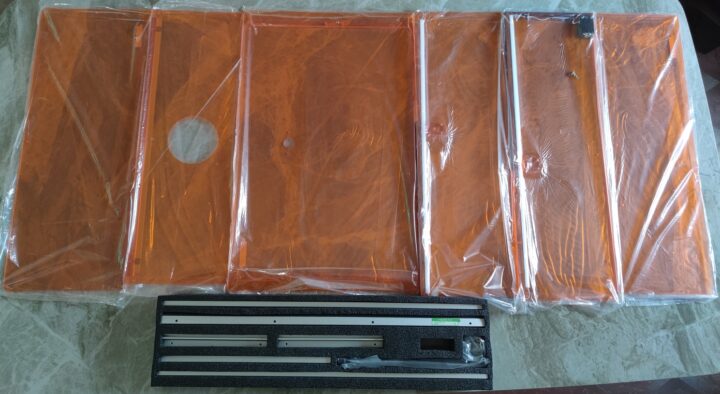
A toolbox includes a 4GB microSD card, a USB Drive Lock, a USB Type-C cable, a screwdriver, some hex keys, a fixed-focus bar, and other accessories.
While the TOOCAA L2 is a fully enclosure laser engraver, the company still included safety goggles with the kit for eye protection.
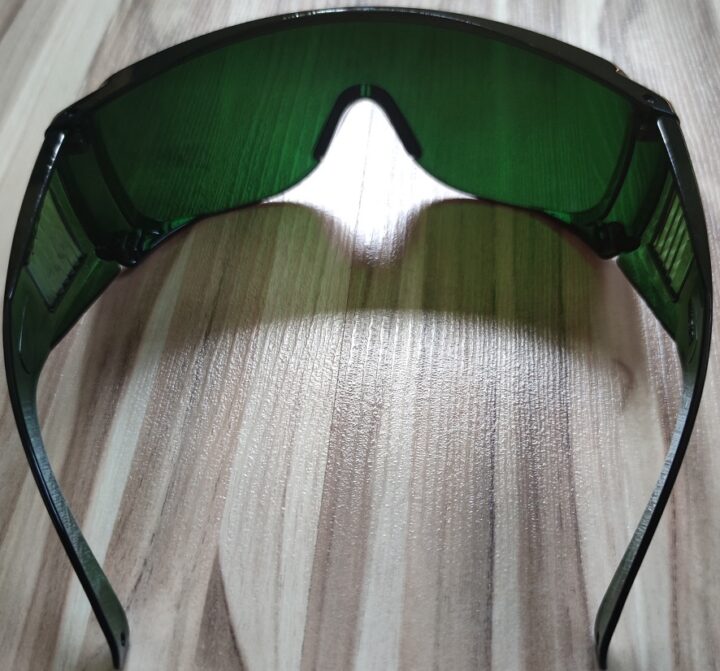
The machine is powered by a 24V/3A adapter that takes 100-240V AC input and outputs through a 5.5mm DC jack.
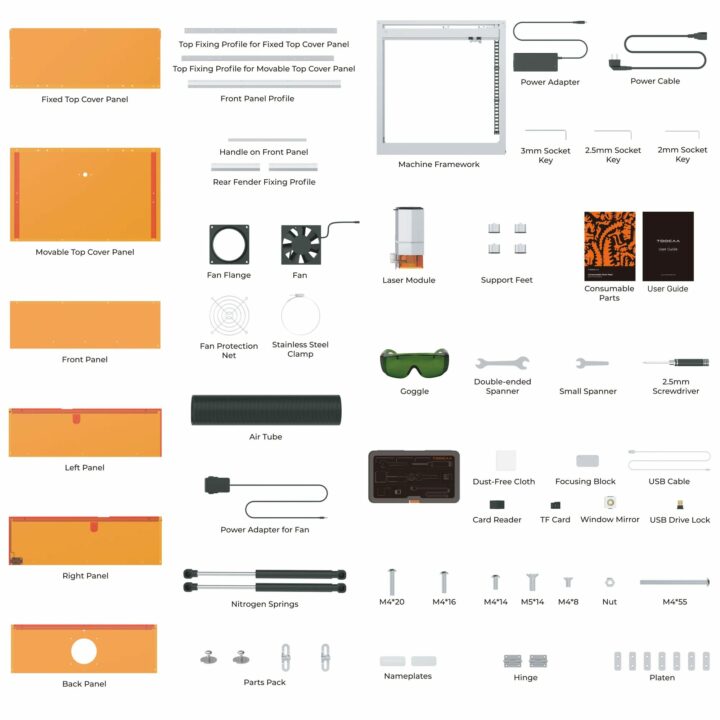
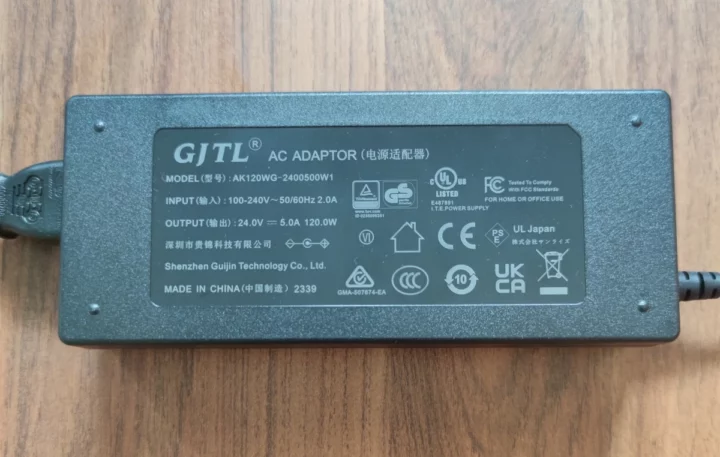
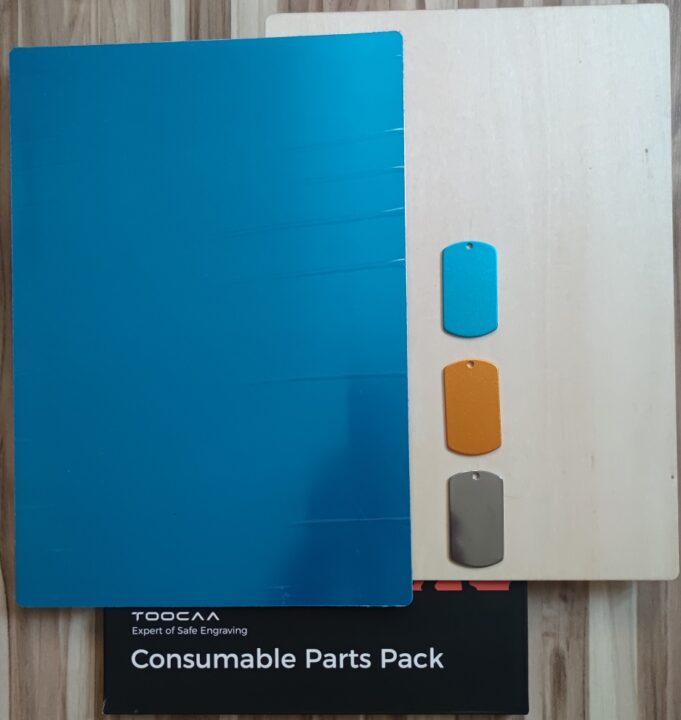
The TOOCAA “consumable parts pack” comes with 1/8″ Basswood plywood, an aluminum sheet, two color aluminum engraving army tags, and one stainless steel army tag.
Let’s now open another package with the honeycomb working panel.
Key features:
- Dimensions – 320 x 320 x 22 mm millimeters
- Used to place materials for cutting or engraving
- Comes with an aluminum sheet (320 x 320 x 1mm) to protect the table/desk
- Materials – Steel and aluminum
The latest package comes with the air assist kit for the TOOCAA L2 machine.
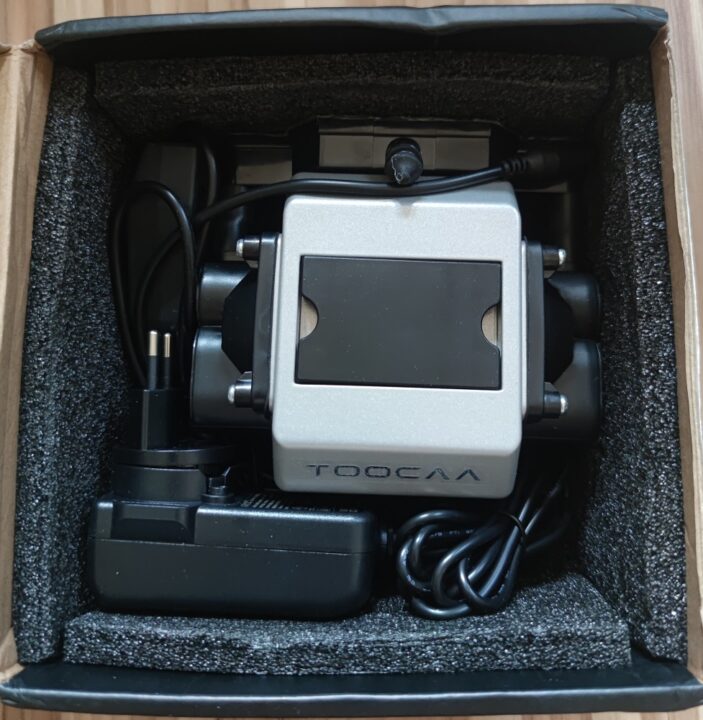
The TOOCAA air assist kit creates a continuous flow of compressed air to blow away the debris and fumes that may occur during the laser engraving or cutting process. It protects the lens and extends the life of the laser module. It also improves the quality of the engraving or cutting job.
Key features
- Maximum airflow – 30 liters/minute
- Noise – 40 dB
- 24V/1A power adapter
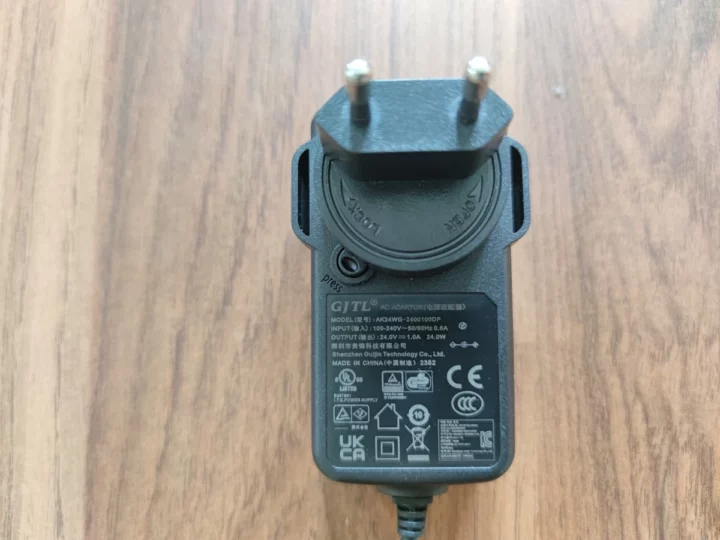
TOOCAA L2 specifications
- Spot size – 0.27 x 0.15 mm
- Working area – 415 x 395 mm
- Engraving speed – Up to 400mm/s
- Input voltage – 24V/5A
- Supported software – LightBurn or LaserGRBL
- Operating System – Windows, MacOS, or Linux
- Connection method – USB Type-C or microSD card
- Dimensions – 645 x 617 x 306 mm
- Weight – 13kg
- Machine material – Aluminum alloy
- “Smart Enclosure material” – Acrylic plate and aluminum alloy
Main types of laser engraving machines
- Diode Laser Engravers – These are optoelectronic devices that convert electrical energy into light. This results in a coherent light of high intensity. which is used to carve objects. This type of machine is becoming very popular with hobbyists due to its small price and affordable pricing.
- CO2 Laser Engravers – These machines use a beam of carbon dioxide to penetrate materials. The efficiency is low and suitable for engraving and cutting non-metallic materials such as paper, cloth, leather, acrylic, and wood.
- Fiber Laser Engravers – Fiber laser machines create a powerful laser beam by sending a high-intensity light down a fiber optic cable. It is generally doped with ytterbium to release high-capacity energy in the form of photons.
Before buying a laser engraving machine you need to know what material you will be working with. For example, carbon dioxide laser machines are ideal for clear acrylic, and diode laser engravers are suitable for woodworking. But engraving metal requires faster speed. Is it necessary to use a galvanic or fiber laser? For beginners, a desktop diode laser engraver seems more suitable because the machine is lightweight, easy to use, and requires little maintenance. Carbon dioxide laser and fiber laser machines require more maintenance.
TOOCAA L2 highlights and tips
Safety features
The TOOCAA L2 is an all-in-one package, assembly is straightforward, and you can use the machine a few minutes after you receive it. There’s very little risk the machine will not work due to user errors after assembly because all the main parts are preassembled. The XY axis movement is provided by slide rails and belts. The laser engraver features two stepping motors using ball-bearing wheels and high-quality aluminum profile rails.
The TOOCAA L2 also focuses on user safety with a fully enclosed design protecting the user from the laser and fumes thanks to an exhaust pipe and fan. Furthermore, the laser module passed Class 1 Laser Safety certification.
Some safety highlights:
- Exhaust Fan – The smoke produced during the cutting process can be released through a window or air purifier making the system safer and healthier to use.
- Tilt Detection – A gyro tilt and collision warning system stops the machine and laser module automatically when the angle between the machine and the horizontal plane is over 15 degrees.
- Flame Detection – The flame detection alarm will stop the laser output when the machine or workpiece is in flames, and the laser module will automatically return to the starting point. The machine needs a restart in this state.
- USB Drive Lock – It is the equivalent of a car key for your laser engraver. The device can only be turned on if the USB Drive Lock is inserted into the USB Type-A port in order to prevent children from using the machine without adult supervision and eliminate associated safety risks.
Supported materials and laser power and speed settings
The TOOCAA L2 laser engraver and cutter can cut or engrave various materials requiring differet laser power and speed settings. The above table lists recommended parameters for different materials, but note these values are for reference only due to variation for a given material. Higher power or slower speeds generally produce deeper results, while lower power or faster speeds produce shallower results.
| Laser Power | Engraving Size | Processing Mode | Material | Thickness (mm) | Power (%)/Speed (mm/min)/Pass |
|---|---|---|---|---|---|
| 10W | 395mm*415mm | Engraving | Basswood | 2 | 40 / 3000 / 1 |
| 10W | 395mm*415mm | Engraving | Bamboo | 5 | 40 / 3000 / 1 |
| 10W | 395mm*415mm | Engraving | Kraft paper | 0.2 | 25 / 3000 / 1 |
| 10W | 395mm*415mm | Engraving | Red card paper | 0.2 | 25 / 3000 / 1 |
| 10W | 395mm*415mm | Engraving | Red felt | 0.8 | 15 / 3000 / 1 |
| 10W | 395mm*415mm | Engraving | Brown leather | 0.65 | 20 / 3000 / 1 |
| 10W | 395mm*415mm | Engraving | Black acrylic | 4.5 | 50 / 3000 / 1 |
| 10W | 395mm*415mm | Engraving | Anodized aluminum | 3 | 100 / 200 / 1 |
| 10W | 395mm*415mm | Engraving | Stainless steel | 2 | 100 / 500 / 1 |
| 10W | 395mm*415mm | Engraving | White Tile Painted Black | 6 | 95 / 3800 / 1 |
| 10W | 395mm*415mm | Cutting | Basswood | 2 | 100 / 350 / 3 |
| 10W | 395mm*415mm | Cutting | Basswood | 4 | 100 / 200 / 1 |
| 10W | 395mm*415mm | Cutting | Basswood | 5 | 100 / 150 / 1 |
| 10W | 395mm*415mm | Cutting | Basswood | 8 | 100 / 230 / 3 |
| 10W | 395mm*415mm | Cutting | Bamboo | 5 | 100 / 230 / 3 |
| 10W | 395mm*415mm | Cutting | Black acrylic | 4.5 | 100 / 120 / 2 |
| 10W | 395mm*415mm | Cutting | Kraft paper | 0.2 | 100 / 3500 / 1 |
| 10W | 395mm*415mm | Cutting | Red card paper | 0.2 | 100 / 3500 / 1 |
| 10W | 395mm*415mm | Cutting | Red felt | 0.8 | 100 / 3500 / 1 |
| 10W | 395mm*415mm | Cutting | Brown leather | 0.65 | 100 / 1500 / 1 |
Adjusting the laser focus
Just like other laser engravers we’ve reviewed the laser focus must be adjusted. A few laser engraving machines support auto-focus, but the TOOCAA L2 required manual focus like many of its peers. Four main steps are required:
- Place the workpiece to be carved
- Unlock the laser head
- Move the focus key down so that it hits the target.
- Lock the laser head
- Please make sure the focal length of the laser module is correct and the lens of the laser module is clean. We can clean it with a dust-free cloth moistened with alcohol when the laser is turned off.
- The focus distance between the laser head and the target will be approximately 1 centimeter.
- The work table should be protected by using steel sheets or other materials that the laser cannot easily penetrate.
Preparing the TOOCAA L2 for use and software
Please turn on the machine in the following order:
- Turn on the air pump
- Turn on the exhaust fan
- Turn on the switch on the laser cutting machine.

Steps before starting laser engraving
- Load the file into the laser cutter
- Place the workpiece and set the starting position for cutting or engraving
- Setting the focus distance
- Close the machine cover.
Laser engraving software
The TOOCAA L2 laser cutter is compatible with the two most popular laser software used by connecting the TOOCAA L2 control board to a computer with a USB Type-C cable:
- Lightburn software to control the laser engraving and cutting machine, and design and edit work pieces. It’s compatible with Windows, macOS, and Linux. Visit the Lightburn official website to download a free trial version for 30 days.
- LaserGRBL is free and open-source software for hobby and professional use released un a GPL v3.0 license. You can download LaserGRBL for Windows on the official website.
Getting started with the TOOCAA L2
TOOCAA provides a file for a “Do Not Disturb” sign in the 4GB microSD and various documents as follows:
- TOOCAA L2 User Guide V1.1.pdf – User manual for the laser engraver
- TOOCAA L2.lbdev – User manual for LightBurn with optimized parameters for the TOOCAA L2
- TOOCAA_L2_Case(10W) V1.0.gc” – G-code sample file for cutting and graving a “Do Not Disturb” sign.
Here are the main steps to get started:
- Insert the USB Drive Lock
- Connect the power cord to the machine.
- Insert the microSD card with a work file (e.g.TOOCAA_L2_Case(10W) V1.0.gc)
- Turn on the machine switch.
- Press the button on the front of the machine once to move the laser head to the starting point of the workpiece.
- Press the button on the front of the machine twice to start the laser engraving process
- After a few minutes, you will get a “Do Not Disturb Sign” sign to attach to your room doorknob.
Remarks: You will want to wear the provided green safety goggles to look at the machine while the machine is operating to protect your eyes from the blue light coming from laser diodes.
Material – 3mm plywood
Dimensions: 17.5 x 6.5 cm
Estimated Time: 18 minutes
You can watch the process (accelerated five times) in the video embedded below.
Detailed testing of the TOOCAA L2 laser engraving and cutting machine
Laser power and speed tests
The first “greyscale test” will make the machine engrave plywood with a sample image with different levels of grey from 5% to 100%. We will be using LaserGRBL for all remaining tests in this review.
Parameters:
- Material – 3mm plywood
- Dimensions – 11 x 8.3 cm
- Engraving Speed – 1,500 mm/minute
- Power – 0 – 40%
- Laser Mode – M4 – Dynamic Power
- Image resolution – 300 dpi
- Estimated Time – 16 minutes
You can watch the engraving for the greyscale test in the video below accelerated by three times.
The next sample is a similar test with varying engraving speeds from 1,000 to 4,000 mm/minute.
- Material – 3mm plywood
- Dimensions – 10 x 7 cm
- Engraving Speed – 1,000 to 4,000 mm/minute
- Power – 0 – 40%
- Laser Mode – M4 – Dynamic Power
- Quality – 8 lines/mm
- Estimated Time – 30 minutes
We’ve also shot a video accelerated by 5 times to show the engraving process in action.
TOOCAA L2 cutting test
The sample below tests cutting at different speeds and with one to four passes.
- Material – 3mm plywood
- Dimensions – 7 x 6 cm
- Engraving Speed – 200 to 1,000 mm/minute
- Power – 80%
- Laser Mode – M3 – Constant Power
- Estimated Time – 5 minutes
This test shows the TOOCAA L2 can cut 3mm plywood at 80% laser power under the following conditions.
- One pass at 200 mm/minute
- Two passes at 200, 400, and 600 mm/minute
- Three passes at 200, 400, 600, and 800 mm/minute
- Four passes at 200, 400, 600, 800, and 1000 mm/minute
The demo video below is accelerated by two times. The air assist pump helps deliver good quality cuts without burned-out areas.
Accuracy test
The small 20x20mm test pattern below is used to check the accuracy of the machine, the thickness of the laser spot, and the laser focus.
- Material – 3mm plywood
- Dimensions – 24 x 22 cm
- Engraving Speed – 1,000 mm/minute
- Power – 0 – 100%
- Laser Mode – M4 – Dynamic Power
- Estimated Time – 1 minute
The video for the accuracy test is shown in real-time.
Shake test
We’ll test the reliability/repeatability of the machine by engraving a small reference cross. Once the cross is engraved, the machine is set to move the laser module in erratic movements along one axis for a couple of minutes and then returns to the original position to engrave the cross again. If the test is successful, the first and second crosses will overlap perfectly. We ran the test twice: once for the X-axis, and another time for the Y-axis, and the results are all good as you can see in the photo and videos below.
Parameters for the X-axis shake test
- Length – 300 mm
- Speed limit – 4000mm/s
- Engraving speed: 1000mm/m and power: 100%
- Estimated Time – 3 minutes
Parameters for the Y-axis shake test
- Length – 200 mm
- Speed limit – 4000mm/s
- Engraving speed: 1000mm/m and power: 100%
- Estimated Time – 1 minute 30 seconds
The X-axis shake test can be seen in the video below in real-time.
Same thing for the Y-axis.
If your engraving machine fails this test, check or do the following:
- The machine does not slip on the table due to vibration during operation
- The table and workpiece did not vibrate during the test
- Adjust the drive belt for proper tension
- Tighten screws and nuts properly
- Make sure the laser module can move freely along its axes without mechanical friction
- Make sure the wires do not act as a barrier to movement
- Try to lower the engraving speed if all these conditions are met, but the machine still does not pass this test.
Summary of TOOCAA L2 test results
We have tested the machine with 4 tests:
- Laser power and speed test
- Cutting test
- Accuracy test
- Shake Test
The TOOCAA L2 20W laser cutting and engraving machine has passed all 4 tests to acceptable levels.
Precautions while using a laser cutting machine
Some materials should not be cut with a laser machine such as all kinds of materials that contain PVC because
- They will emit toxic gases that are dangerous to living things
- The fumes will adhere to the lens of the laser cutter shortening the lifespan of the lens
One more danger is the risk of fire when using flammable materials or if the user is not actively monitoring the cutting of a workpiece. If a fire has been ignited follow the steps below:
- Open the machine cover
- Find a cloth and slap the fire to extinguish it
- Use a dry chemical fire extinguisher as the last resort since it may cause damage to the laser-cutting machine.
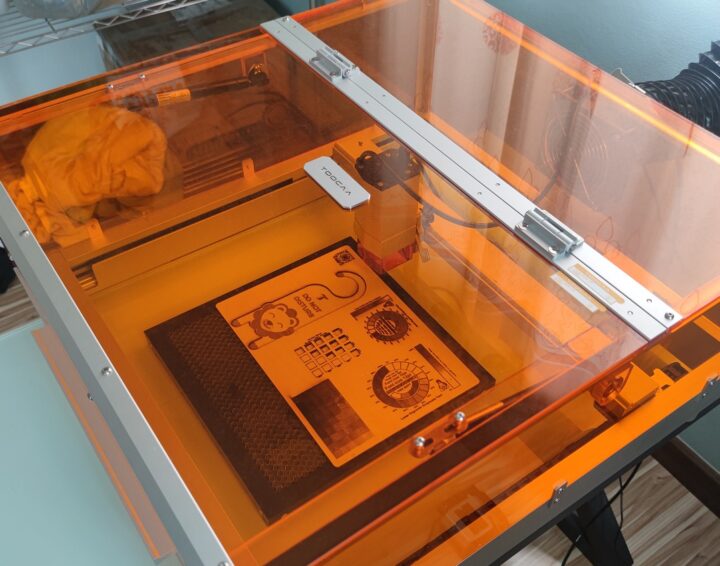
Conclusion
ELECFREAKS is a company founded in 2011 primarily engaged in Arduino peripherals and maker hardware, but they introduced the TOOCA brand (now TOOCAA) for laser engraver and cutting machines in 2022, and we reviewed the TOOCA L1 5W laser engraver at that time.
The TOOCAA L2 is available with a 10 Watts or 20 Watts laser module, and our sample was equipped with the latter. The machine is designed with a strong structure made of an aluminum frame with X and Y axes and ships mostly pre-assembled and ready to use after installing the orange clear acrylic covers. The TOOCAA L2 heavily focuses on safety, as besides being a fully enclosed laser engraving and cutting machine, it also features various safety measures such as an exhaust fan, a USB drive lock to prevent children from starting the machine without adult supervision, and tilt and flame detection mechanisms to stop the machine in case of unexpected events such as falls or fires.
The laser engraver and cutter allows users to create high-definition cutting and engraving workpieces such as carved designs on containers, name tags, rubber stamps, frames for Buddha amulets, and more.
We’d like to thank TOOCAA for sending the TOOCAA L2 20W laser engraver & cutter for review along with various accessories. The model reviewed can be purchased on the TOOCAA website for $1,099, while the 10 Watts model starts at $849. Note that the price does not include the air assist kit and the honeycomb working table which are available separately for $129.99 and $69.99 respectively.
CNXSoft: This review is a translation of the original article on CNX Software by NinePhon Kongangkab, edited by Suthinee Kerdkaew.

Jean-Luc started CNX Software in 2010 as a part-time endeavor, before quitting his job as a software engineering manager, and starting to write daily news, and reviews full time later in 2011.
Support CNX Software! Donate via cryptocurrencies, become a Patron on Patreon, or purchase goods on Amazon or Aliexpress


